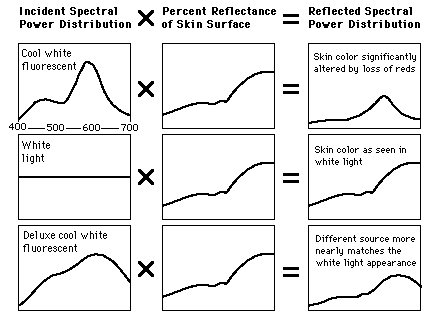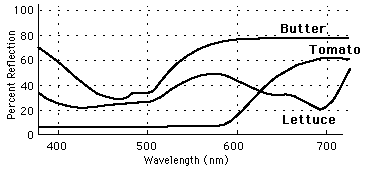Example of Spectral Power Distribution Application

| SPD example for common colors | Calculation of chromaticity |
Vision concepts
Color vision
Color measurement
Reference
Williamson & Cummins
| HyperPhysics***** Light and Vision | R Nave |
Spectral Power DistributionLight may be precisely characterized by giving the power of the light at each wavelength in the visible spectrum. The resulting spectral power distribution (SPD) contains all the basic physical data about the light and serves as the starting point for quantitative analyses of color. The SPD can be measured by a spectrophotometer. From the SPD both the luminance and the chromaticity of a color may be derived to precisely describe the color in the CIE system. Other systems of color measurement can also be related to the SPD. These systems have been successful in predicting color perception from the SPD, but it is not possible to proceed in the opposite direction. That is, the SPD cannot be predicted from the characteristics of the color as perceived by the human eye. The SPD of light from an illuminated surface is the product of the percent reflectance of the surface and the SPD of the light which falls on the surface.
|
Index Vision concepts Color vision Color measurement Reference Williamson & Cummins | |||
|
Go Back |
Example of Spectral Power Distribution Application
|
Index Vision concepts Color vision Color measurement Reference Williamson & Cummins | ||
|
Go Back |
Example of Spectral Power Distribution ApplicationAn example of the spectral power distribution of light from common objects shows that such colors arise from a range of wavelengths. Even the vivid red of a tomato involves a range of wavelengths in the red region of the visible spectrum. 
|
Index Vision concepts Color vision Color measurement Reference Williamson & Cummins | ||
|
Go Back |